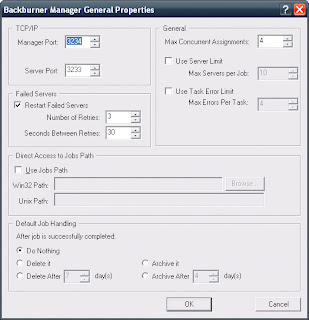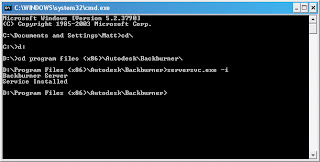Backburner has its weaknesses as well. For example, if you are rendering on a headless machine or one on the other side of the office you have no idea how much progress has been made on a single frame...that's kind of a bummer. Its also a pain to go around, login to machines and start the Backburner manager, and start the Backburner server. You can put shortcuts to the respective application in the startup folder of each computer but this means that the machine has to be logged in which isn't difficult but its a pain.
The smart thing to do is to install Backburner as a service which will run as soon as windows boots. This is great for your headless machines and you have very little worry that a user might say "Backburner? what the heck is that?" and delete from the startup menu. If a user knows how to go in and kill a service this person is a nerd and is likely already a part of your team (in which case he or she wouldn't want to kill the service).
As you probably already know, Backburner relies on a server application and a manager application. The manager application manages the jobs and the server application executes the jobs. I like to run the manager on a machine that will not take part in the rendering just in case the render job crashes a machine (I run it on my file server). Both applications can be run as services and the installation process is basically the same. Before you install the server service or the manager service you need to make sure that each application is configured correctly.
For manager go to:
start - applications - Autodesk - Backburner - manager
When it fires up, you'll see something like this:

I've never found any reason to change these settings but you might. Make note of the Manager and Server ports, if you have a pesky firewall you might need to open them up. Go ahead and hit ok. Now the Backburner manager is running.
Let's leave manager running and configure the server.
Start - applications - Autodesk - Backburner - server
You'll see something like this:

I like to resolve the connection to my Manager using the machine name, in this case "Ele-srvr01" you can use IP address or "Automatic Search" if you like. IP address is a bad idea if your addresses are assigned dynamically and "Automatic Search" is a bad idea if you are on a large network with multiple subnets. Machine name works well in most environments provided that you intend to always run the manager on the same machine (which I do). Filling in a description is a good idea if you are on a large network and have access to lots of machines. In those cases, I'll enter the name of the person who works on that machine (easier to remember than some weirdo computer name that you IT staff created). Go ahead and hit "ok". Now your server is running and it will look like this:

You want to look for the line which reads "Registration to
Now to install the server service you need to open a command prompt. Start - run - type in "cmd" A command prompt will open. You can install the service by following the steps that you see below. Please note, my Backburner is installed at d:\Program Files (x86)\Autodesk\Backburner\ yours may not be...you'll have to find it.

As you can see I've received a message which indicates that the Backburner Server Service has been installed.
The manager service installs in exactly the same way. Should you find that you need to uninstall the service replace "-i" with "-r" (install, remove). The next step is to get these services running under a user account with sufficient privileges to access the network, which is critical. I'll cover this in my next post (which is all ready to go).
Backburner is a friend. Check out the script on Lesterbanks to be able to use it with Maya's new render layer system.
ReplyDelete